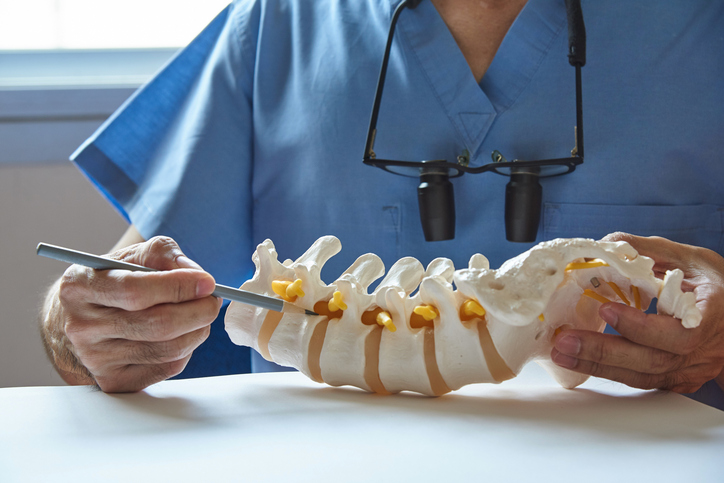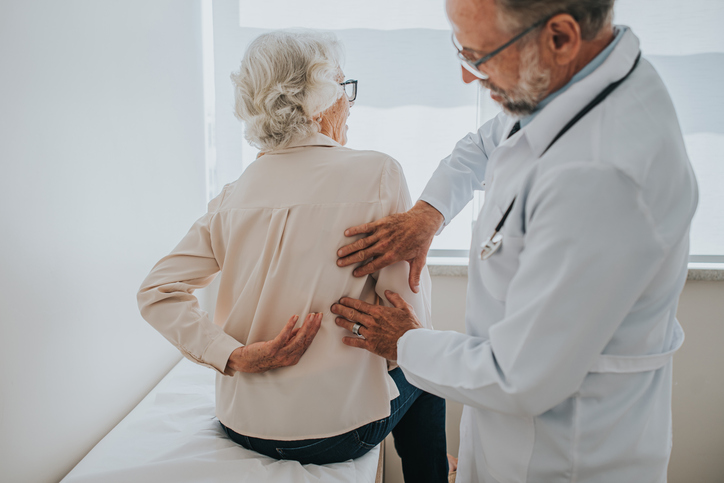Osteoporosis and Bone Health
Osteoporosis and Bone Health
Osteoporosis and Bone Health
Osteoporosis is the number one cause of broken bones in older people. It tends to run in families, but people don’t always realize they’re at risk.
This is why Carilion Clinic started the Bone Health Clinic. We specialize in diagnosing and treating people with osteoporosis or who are at risk for it. We want to help you keep your bones strong for years to come.
Here’s what you need to know about osteoporosis and protecting your bone health.
Osteoporosis is the number one cause of broken bones in older people. It tends to run in families, but people don’t always realize they’re at risk.
This is why Carilion Clinic started the Bone Health Clinic. We specialize in diagnosing and treating people with osteoporosis or who are at risk for it. We want to help you keep your bones strong for years to come.
Here’s what you need to know about osteoporosis and protecting your bone health.
Osteoporosis is a bone disease. Sometimes it’s called a silent disease, because you may not have symptoms. For many people, the first symptom is a broken bone.
With age, our bones lose density and mass. If you have too much bone loss, it affects the structure and strength of your bones. They can break more easily.
Osteoporosis can affect any bone, but hips, wrists and the bones of your spine are most at risk.
Osteoporosis isn’t curable, but it is treatable. If we catch it early, we can slow the progression of bone loss. With modern technology, we can screen for it better than ever before.
Is Paget’s disease related to osteoporosis?
Paget’s disease is a chronic bone disease that usually affects people over the age of 55. Like osteoporosis, it can lead to bone breaks.
Paget’s is not the same disease as osteoporosis (though a person can have both). Paget’s has different causes and can lead to enlarged or misshapen bones.
However, Paget’s and osteoporosis both use some of the same treatments. We see both conditions in our Bone Health Clinic.
What Is Osteoporosis?
Osteoporosis is a bone disease. Sometimes it’s called a silent disease, because you may not have symptoms. For many people, the first symptom is a broken bone.
With age, our bones lose density and mass. If you have too much bone loss, it affects the structure and strength of your bones. They can break more easily.
Osteoporosis can affect any bone, but hips, wrists and the bones of your spine are most at risk.
Osteoporosis isn’t curable, but it is treatable. If we catch it early, we can slow the progression of bone loss. With modern technology, we can screen for it better than ever before.
Is Paget’s disease related to osteoporosis?
Paget’s disease is a chronic bone disease that usually affects people over the age of 55. Like osteoporosis, it can lead to bone breaks.
Paget’s is not the same disease as osteoporosis (though a person can have both). Paget’s has different causes and can lead to enlarged or misshapen bones.
However, Paget’s and osteoporosis both use some of the same treatments. We see both conditions in our Bone Health Clinic.
The number one risk factor for osteoporosis is aging. Osteoporosis is also more common in women than men.
Other risk factors and causes include:
- Genetics: If one of your parents has osteoporosis, you’re at a higher risk
- Body size: Being slender with thin bones means you have less bone mass to begin with
- Race: White and Asian women are at the highest risk for osteoporosis
- Menopause: Low estrogen levels after menopause can contribute to bone loss
- Not being physically active: Being inactive can speed up the process of bone loss
- Alcohol: Chronic heavy drinking can increase your risk
- Smoking: Smoking increases your risk, though researchers are trying to understand whether tobacco alone is the risk factor
Taking certain medications might make you more likely to develop osteoporosis. However, many of these medications have important benefits. They may treat conditions like cancer, depression and diabetes. You and your doctor should look at the whole picture of your health when deciding on medications.
What Causes Osteoporosis?
The number one risk factor for osteoporosis is aging. Osteoporosis is also more common in women than men.
Other risk factors and causes include:
- Genetics: If one of your parents has osteoporosis, you’re at a higher risk
- Body size: Being slender with thin bones means you have less bone mass to begin with
- Race: White and Asian women are at the highest risk for osteoporosis
- Menopause: Low estrogen levels after menopause can contribute to bone loss
- Not being physically active: Being inactive can speed up the process of bone loss
- Alcohol: Chronic heavy drinking can increase your risk
- Smoking: Smoking increases your risk, though researchers are trying to understand whether tobacco alone is the risk factor
Taking certain medications might make you more likely to develop osteoporosis. However, many of these medications have important benefits. They may treat conditions like cancer, depression and diabetes. You and your doctor should look at the whole picture of your health when deciding on medications.
There are certain risk factors for osteoporosis you can’t change. That’s why it’s important to control the ones you can.
Here are some steps you can take to reduce your risk and keep you safe from fractures.
- Stay active: All exercise helps, but weight-bearing and strength training are especially important to help keep bones strong. Try activities like walking, jogging and dance.
- Get enough calcium and vitamin D: Eating foods rich in these vitamins can help, but your doctor may also recommend supplements.
- Limit your alcohol: We know there’s a link with heavy alcohol use; it can also be a risk for falling, which can lead to a fracture. Only drink in moderation.
- If you smoke, work to quit: Carilion can help you quit smoking.
- Take medicine your doctor prescribes: Some medicines can help prevent fractures in people with osteoporosis. Always take them as prescribed, because timing matters.
Can I Prevent Osteoporosis?
There are certain risk factors for osteoporosis you can’t change. That’s why it’s important to control the ones you can.
Here are some steps you can take to reduce your risk and keep you safe from fractures.
- Stay active: All exercise helps, but weight-bearing and strength training are especially important to help keep bones strong. Try activities like walking, jogging and dance.
- Get enough calcium and vitamin D: Eating foods rich in these vitamins can help, but your doctor may also recommend supplements.
- Limit your alcohol: We know there’s a link with heavy alcohol use; it can also be a risk for falling, which can lead to a fracture. Only drink in moderation.
- If you smoke, work to quit: Carilion can help you quit smoking.
- Take medicine your doctor prescribes: Some medicines can help prevent fractures in people with osteoporosis. Always take them as prescribed, because timing matters.
At our Bone Health Clinic, we help people manage osteoporosis and other conditions that weaken bones. We believe you should manage osteoporosis before it manages you.
We start by doing a bone scan screening. This is a noninvasive test that scans your bones, assessing their strength.
We’ll also do:
- Bloodwork: We'll check levels of calcium, vitamin D and other markers related to bone health
- Nutritional assessments: We'll see what diet changes may help
- Fall risk assessments: We'll see what preventive measures can help you stay safe
Depending on the results, your family history and other risk factors, we may prescribe:
- Lifestyle changes: We can help you make diet changes, start an exercise program or quit smoking.
- Medicine: There are several medicines we use, from daily, weekly or monthly pills to injections or infusions.
- Physical therapy: Working with a physical therapist can help strengthen the muscles and joints that support your bones. It can also help improve balance, which helps prevent falls.
Surgery for osteoporosis
Osteoporosis can cause tiny fractures in your spine, pelvis, wrist and shoulder that are painful and limit your mobility. At times, these fractures in the spine can also make you lose height, because the bones of your spine start to shrink.
If other treatments aren’t helping, there are 2 minimally invasive surgical procedures we do:
- Balloon kyphoplasty: A small balloon is inserted into the fractured bone to restore its height and relieve pain
- Vertebroplasty: A special cement is injected into the fractured vertebra to stabilize it and reduce pain
We also work closely with Carilion’s orthopaedic surgeons to treat any other fractures you may have.
How We Treat Osteoporosis and Bone Conditions
At our Bone Health Clinic, we help people manage osteoporosis and other conditions that weaken bones. We believe you should manage osteoporosis before it manages you.
We start by doing a bone scan screening. This is a noninvasive test that scans your bones, assessing their strength.
We’ll also do:
- Bloodwork: We'll check levels of calcium, vitamin D and other markers related to bone health
- Nutritional assessments: We'll see what diet changes may help
- Fall risk assessments: We'll see what preventive measures can help you stay safe
Depending on the results, your family history and other risk factors, we may prescribe:
- Lifestyle changes: We can help you make diet changes, start an exercise program or quit smoking.
- Medicine: There are several medicines we use, from daily, weekly or monthly pills to injections or infusions.
- Physical therapy: Working with a physical therapist can help strengthen the muscles and joints that support your bones. It can also help improve balance, which helps prevent falls.
Surgery for osteoporosis
Osteoporosis can cause tiny fractures in your spine, pelvis, wrist and shoulder that are painful and limit your mobility. At times, these fractures in the spine can also make you lose height, because the bones of your spine start to shrink.
If other treatments aren’t helping, there are 2 minimally invasive surgical procedures we do:
- Balloon kyphoplasty: A small balloon is inserted into the fractured bone to restore its height and relieve pain
- Vertebroplasty: A special cement is injected into the fractured vertebra to stabilize it and reduce pain
We also work closely with Carilion’s orthopaedic surgeons to treat any other fractures you may have.
Carilion blends research with practice to deliver exceptional orthopaedic care. That means you always get the best of both worlds—expert care and the latest innovation.

Largest orthopaedic practice in Virginia
We have nearly 50 orthopaedic doctors, including more than 35 orthopaedic surgeons, podiatrists and physiatrists. We understand the needs of all the different populations in our community and treat all ages.

Latest osteoporosis treatment options
We offer the latest medicines and other treatments. But we also provide comprehensive care, including exercise programs to help to quit smoking.
Why Choose Carilion Clinic?
Carilion blends research with practice to deliver exceptional orthopaedic care. That means you always get the best of both worlds—expert care and the latest innovation.
Patient Stories
She showed me the difference in how bad my bones had declined from 2 years ago."
Health and Wellness

Keep Your Bones Strong to Avoid Osteoporosis

4 Ways to Keep Your Joints Happy

Schedule Back-to-School Doctor Visits Early
Get Care at Carilion Clinic
Your path to better health starts here. Explore comprehensive care options and find the support you need for every step of your wellness journey.
Get Care at Carilion Clinic
Your path to better health starts here. Explore comprehensive care options and find the support you need for every step of your wellness journey.
Get Care at Carilion Clinic
Your path to better health starts here. Explore comprehensive care options and find the support you need for every step of your wellness journey.
Get Care at Carilion Clinic
Your path to better health starts here. Explore comprehensive care options and find the support you need for every step of your wellness journey.
